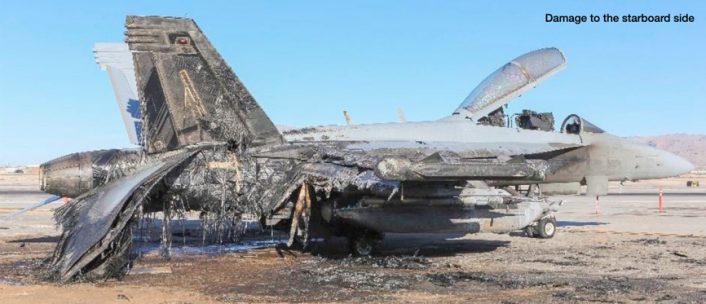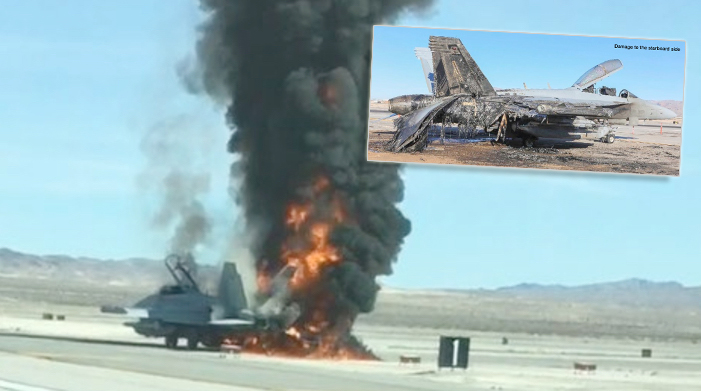The aircraft was launching for a Red Flag mission when it suffered an uncontained engine failure.
As some of our readers will probably remember, a Royal Australian Air Force (RAAF) EA-18G Growler aircraft was involved in an incident on Jan. 27, 2018, at Nellis AFB, outside Las Vegas, Nevada.
The aircraft serialled A46-311, one of a contingent of four RAAF No. 6 Squadron’s EA-18G Growlers attending Red Flag 18-1 air combat exercise, suffered an uncontained engine failure on take off. According to the RAAF investigation, one of the aircraft’s General Electric F414 turbofan engines broke into three major pieces with one segment piercing through the airframe, another one going through the second engine and a third one destroying the right hand side tail.
“At ~140 knots indicated air speed (KIAS), the ballistic material failure of the right hand engine caused the almost simultaneous failure of the left hand engine, a cascading set of malfunctions and emergencies and a fierce fuel / airframe fire. Confronted with a marked increase in vibration and ambient noise, the crew completed their ‘bold face’ actions for multiple major malfunctions,” says the RAAF investigation report. “About four seconds after the failure of both engines, the situation was further compounded by the loss of all generated electrical systems; which disabled, amongst others, the Digital Display Indicators (DDIs), Multipurpose Colour Display (MPCD), Head-up Display (HUD) and anti-skid braking. Whilst under emergency (system) braking, both the left and right main undercarriage tyres burst, severing the hydraulic line that serves the left hand undercarriage brake. The aircraft was kept on the runway using a combination of differential braking (from a dissipating hydraulic system) and aerodynamic / physical drag. Approaching the runway’s first arresting barrier, the aircraft departed the prepared surface to the right (at about 8,400 feet of the 10,000 foot runway). Carrying an estimated 50 knots of groundspeed into the sand based margin, the aircraft passed outboard of the starboard anchor housing for the arrestor cable. Remaining upright and influenced by the additional drag of the sand, the aircraft slowed and yawed left (back through the runway heading) before coming to rest on an adjoining intersection, marginally right of the runway in use, 9,100 feet from the initial departure point. Confronted by the significant fuel / airframe fire, the aircrew made a rapid egress from the cockpit, via the port side of the leading edge extension (LEX), gathering at a safe point upwind of the aircraft. The pilot was later treated for smoke inhalation, whilst the Electronic Warfare Officer (EWO) remained physically unharmed (save bruising).”

As the jet came to a halt, the rear fuselage caught fire, the main landing gear collapsed and two of the three ALQ-99 pods got damaged: the aircraft suffered damages considered “beyond repair” and as a consequence it was withdrawn from use. An incident, caused by the uncontained failure of the 1st stage fan disc of the right engine, which instigated the accident “chain of events” that cost the RAAF some 125M USD according to most reports.
“The uncontained failure of the 1st stage fan disc was considered to be an unusual event by metallurgists,” the investigation report states. “Subsequent discussions with the OEM sub-contractor responsible for producing the 1st stage fan disc forgings revealed that they had previously experienced three cracked forgings during manufacture, affirming the conclusion that the failure of A46-311 engine component was introduced during the forging process. 1st stage fan discs originate from forging lots, with varying numbers of forgings comprising a lot.2 A46-311’s cracked 1st stage fan disc was from the OEM’s subcontractor Lot 61, forged in 2015. It was one of 31 forgings in the Lot. Initially, there were three Lots of interest which were installed in in-service F414 engines, necessitating both the RAAF and USN to introduce an operational pause (OP) to F414 engine flying operations. One third of the RAAF’s F414 engine fleet were, by analysis, affected and subsequently investigated.”
Immediately after the investigation report was released, the Australian Defense Department tried to claim compensation through a convoluted process that would see the claim go through United States Navy then on to Boeing who makes the Growler, and eventually to General Electric, who makes the F414 engine. However, the request was rejected in the very early stages.
In fact, ABC News in Australia reported that Air Vice Marshal Greg Hoffman, the head of the Defence Department’s Aerospace Systems Division, told Senate Estimates that Australian taxpayers will have to foot the bill: “The US Navy has formally written to us and advised that unfortunately, and it is very unfortunate that we can’t get compensated for this, but the position is there is no compensation,” he said. According to Hoffman, the United States Navy would also receive no compensation from the contractor if it experienced a similar mishap: “The owner and operator holds the liability for the aeroplanes. And what we found out is in this case, the United States’ Navy, should they have lost this aeroplane, they similarly would not have been compensated for it (by) the contractor.”
Commercial agreements that the Australian Defense was not aware of until recently did not include a “warranty” and the RAAF Electronic Attack capability is now reduced by about 10 percent: 11 of the original 12 RAAF EA-18G remain in service.
The service received their first EA-18G Growlers in 2017 although the first RAAF EA-18G Growler instructor pilot began flying the electronic warfare aircraft in the U.S. at Naval Air Station Whidbey Island in the United States in November 2013. Production of the first of 12 RAAF EA-18G Growlers began in 2015. Before that, RAAF flight crews trained on the U.S. EA-18Gs with the U.S. Navy’s Electronic Attack Squadron 129, “The Vikings”, permanently stationed at NAS Whidbey Island, in Washington state.
The RAAF could consider replacing the EA-18G with a new build aircraft or convert one of their F/A-18F Super Hornets they ordered to Growler standard. Brand new aircraft can crash for technical reasons and contingency plans are often required to deal with such losses. Fortunately, in this case the RAAF has not lost any crew member whose “cost”, in every sense, would have been much higher.









